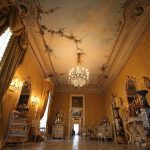
DESTINATION
palazzo francavilla
(SIB Congress 2025 – SOCIAL DINNER SEPTEMBER 11th)
Palazzo Francavilla main entrance is in via Ruggiero Settimo and the palace overlooks Piazza Verdi opposite Teatro Massimo. Built in 1783 in Palermo’s countryside, the palace two main features are: firstly, it benefited from the town enlargement which took place at the end of the XVIIIth century and secondly, in 1801 it was bought by Saverio Oneto and Gravina duke of Sperlinga, an aristocrat of the inner circle of the Bourbon kings of Naples, who for health reasons was forced to leave his city palace and to move to the countryside, beyond Porta Maqueda.
He charged some artists such as Giuseppe Velasco, Giuseppe Patania and Natale Carta, with the task of frescoing the sitting rooms facing north.
In 1893 Luigi Majorca Earl of Francavilla, the heir of the dukes of Sperlinga, summoned Ernesto Basile, the gifted artist of Palermo Art- Nouveau architecture, in order to renovate the palace façades and to settle the final arrangement of the interiors; the architect was at the time supervising the works for the building of Teatro Massimo.
Architect Basile designed, apart from the façades and the two large halls, the furniture of the entrance room and the showcases displaying the clothing of the family ladies and noblemen; but most of all, he personally took part in the accomplishment of the library, where some important volumes concerning Sicilian topics are kept.
The vaults of the drawing rooms facing via Ruggiero Settimo and Piazza Verdi were painted by Rocco Lentini, Luigi Di Giovanni and Giuseppe Enea, who were then considered some of the most outstanding artists, whereas some walls were embellished by the marble medallions representing the faces of some of the family ancestors sculpted by Benedetto Civiletti, Antonino Ugo and Mario Rutelli.





